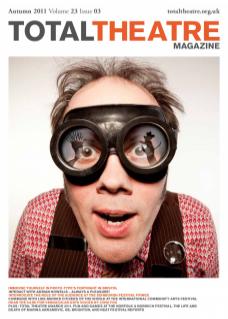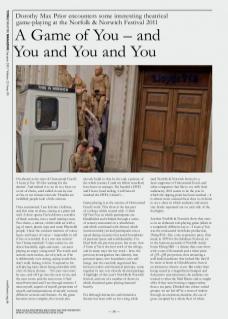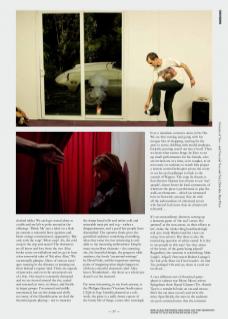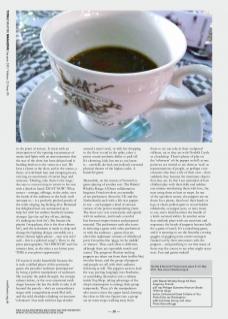Overheard at the start of Ontroerend Goed’s A Game of You: ‘It’s like waiting for the dentist’. And indeed it is: we sit in a foyer on a row of chairs, until called in one-by-one at five or ten minute intervals. Thumbs are twiddled; people look a little anxious.
Once summoned, I am led into a hallway, and this time sit alone, staring at a plain red wall. A door opens; I’m led down a corridor of black curtains, into a small waiting room. Two chairs, a mirror, a little table set with a jug of water, plastic cups and some Playmobil people. I hear the constant murmur of voices: layers and layers of voices – impossible to tell if live or recorded. Is it a two-way mirror? Am I being watched? A man comes in, sits down forcefully, sighs and rants – an actor playing an angry young man? The words and actions seem untrue, out-of-synch, as if he is deliberately over-acting, saying words that don’t really belong to him. I respond to his self-pitying rants about being unlovable with a bit of cheery chatter… ‘It’s your turn now,’ he says, and off I go into the next room, and the next room, and the next room. I find myself mirrored and I see through mirrors. I meet myself, aspects of myself, projections of myself, and interpretations of myself, in many different versions and formats. As the game becomes more complex, the reveals also cleverly build so that by the end, a picture of the whole journey I (and my fellow travellers) have been on emerges. I’m handed a DVD and I leave, head reeling. I still haven’t watched the DVD, I daren’t…
Game-playing is at the essence of Ontroerend Goed’s work. This show is the last part of a trilogy which started with A Smile Off Your Face, in which participants are blindfolded and whisked through a series of sensory encounters in a wheelchair; and which continued with Internal, which (controversially) invited participants into a speed-dating scenario that tested boundaries of personal space and confidentiality. I’ve liked both the previous parts, but in my view A Game of You is the best work of the trilogy, and in many ways the key work – here, the previous investigations into identity, into personal space, into boundaries, into selfimage, into the carefully negotiated line between reality and theatrical pretence, come together in one very cleverly devised package. A highlight of this year’s Norfolk & Norwich festival, and one of a number of shows in which theatrical game-playing featured heavily.
For although interactive and immersive theatre has been with us for a long while (and Norfolk & Norwich festival is a keen supporter of Ontroerend Goed, and other companies that like to toy with their audiences), 2011 seems to be the year in which the tipping point has been reached – it is almost more unusual these days to sit down to see a show in which audience and actors stay firmly separated out on each side of the footlights.
Another Norfolk & Norwich show that casts us in an elaborate role-playing game (albeit in a completely different way to A Game of You) was the remounted Artichoke production, Dining With Alice, a site-responsive piece (first made in 1999 for the Salisbury Festival) set in the luscious grounds of Norfolk stately home Elsing Hall – a dinner-date cum show with a cast of thousands and a ticket price of £55–£85 per person, thus attracting a well-heeled audience that looked like they’d be more at home at Glyndebourne than at an immersive theatre event. But rather than being seated at a magnificent banquet and fed passive entertainment, the audience are treated to what the Mad Hatter and co might offer if they were hosting a supper rather than a tea party. Divided into colour-coded groups, we are led off by a team of waiters through an enormous meadow, the sea of grass occupied by a whole fleet of white clothed tables. We each get seated alone at a table and are left to poke around at the offerings. ‘Drink Me’ says a label on a little jar contain a colourful brew (quinine and bitter orange constitutional, apparently), ‘But only with the soup’. What soup? Ah, the cold soup in the cup and saucer! The characters we all know and love from the two Alice books come on walkabout and we get to hear a few sorrowful tales of ‘life after Alice’. We occasionally glimpse Alices of various sizes/ ages running in the distance or peeping out from behind a topiary bird. There are squeals of peacocks, and even the occasional roar of a lion. Our meal is constantly disrupted and we are moved around the site, seated and reseated; in twos, in threes, and finally in larger groups. I’m amused and mildly entertained, but on this damp and chilly eve many of the Glyndebourne set find the theatrical game-playing – not to mention the damp bread rolls and rather cold and miserable meat pie and veg – rather a disappointment, and a good few people leave dissatisfied. The operetta finale gives the gentrified audience something resembling what they came for, but witnessing it only adds to my mounting ambivalence. Despite many marvellous elements – the stunning site, the beautiful design, the gorgeous table artefacts, the lovely ‘occasional writings’ by David Gale, and the ingenious starting point of imagining what might happen to all those colourful characters after Alice leaves Wonderland – the show as a whole just doesn’t cut the mustard.
Far more interesting, in my book anyway, is the Philippe Quesne/Vivarium Studio piece L’Effet de Serge. Initially planned as a solo work, the piece is a sadly funny expose of the lonely life of Serge, a man who seemingly lives a mundane existence alone in his flat. We see him coming and going with his meagre bits of shopping, waiting for the post to arrive, fiddling with model airplanes, listlessly pouring cereal out into a bowl. Then we learn what excites Serge: he likes to set up small performances for his friends, who are invited one at a time, or in couples, to sit nervously on cushions to watch him propel a remote control helicopter across the room or set his car headlamps to flash to the sounds of Wagner. The coup de theatre is that director Quesne has chosen to use ‘real people’, drawn from the local community of wherever the piece is performed, to play the walk-on characters – which (as witnessed here in Norwich, anyway) they do with all the awkwardness of untrained actors who haven’t had more than an afternoon’s rehearsal…
It’s an extraordinary decision, setting up a fantastic game of ‘the real’ versus ‘the pretend’ as the non-actors, in their efforts to ‘act’, make the whole thing heartbreakingly real (cue Andy Warhol and his views on using ‘non-actors’). But there is also the interesting question of ethics raised. Is it fair to use people in this way? Are they aware of the irony; of the game being played? Regardless, the outcome is astonishing: Mike Leigh’s Abigail’s Party meets Robert Lepage’s Far Side of the Moon via Tim Crouch’s An Oak Tree, perhaps? Oh and yes, there is a real car involved…
A very different sort of theatrical gameplayer is cabaret star Meow Meow, whose Spiegeltent show Beyond Glamour (The Absinthe Tour) is a wonderful take on cat-and-mouse. She’s the cat (mee-ooow!) and we’re the mice. Specifically, the men in the audience are poor cornered mice that she torments to the point of torture. It starts with an interruption of the opening razzamatazz of music-and-lights with an announcement that the star of the show has been delayed and is heading hotfoot to the venue in a taxi. We hear a clatter at the door, and in she comes, a flurry of wild black hair and clomping boots, carrying an assortment of carrier bags and suitcases. ‘Darling, take them to the stage,’ she says to a man trying to return to his seat with a drink in hand, ‘DO IT NOW’. What ensues – onstage, offstage, in the aisles, over the heads of the audience as she body surfs amongst us – is a perfectly pitched parody of the torch-singing, leg-kicking diva. Bemused but delighted men are summoned up to help her with her endless botched costume changes (‘get the red bra off me, darling, it’s making me look fat’). She berates the pianist (‘stop please, this is the slow vibrato bit’), and the technician is made to chop and change the lighting design, ostensibly on a whim (‘skinny lights please… now red, red I said – this is a political song!’). Then, to the press photographer, ‘NO PHOTOS!’ and five minutes later, as she takes a sex-kitten pose ‘THIS is your photo opportunity’.
Of course it works beautifully because she is such a skilled player of this particular game: she parodies ‘audience participation’ by being a perfect manipulator of audiences. She can play the jaded showgirl, the stroppy cabaret artiste, or the over-emotional torch singer because she has the skills to take it all beyond the parody – she’s an extraordinary singer with a magnificent mock-Piaf trill, and the wild shoulder-climbing on innocent ‘volunteers’ that ends with her legs akimbo around a man’s neck, or with her dropping to the floor to end in the splits, takes a pretty sound acrobatic ability to pull off. It’s clowning, kids, but not as you know it… carefully devised, meticulously executed physical theatre of the highest order. A beautiful game.
Meanwhile, on the streets of Norwich is game-playing of another sort. The Babok/ Whalley Range All Stars collaboration Imaginary Friends involves an ensemble of ten performers (from the UK and the Netherlands) each with a life-size puppet in tow – each puppet a kind of cartoon version of the person manipulating them. The show toys very consciously and openly with its audience, and treads a careful line between improvisation and prepared material. The performers each take turns in initiating a game with other performers or with the audience – games that are often like nightmare versions of childhood party favourites like ‘piggy in the middle’ or ‘statues’. Thus, each show is different, although there are repeatable motifs and scenes. The gorgeous Hessian-sacking puppets are taken out from their (coffin-like) wooden boxes, and the group of puppetsand-people set off, with their audience following at will. The puppets seem to lead the way, peering longingly into Starbucks, or assembling themselves into a tableau inside Top Shop, taking advantage of the shop’s mannequins to enlarge their group temporarily. Then, it’s the manipulators who seem to have the upper hand, forming the close-to-life-size figures into a group sat on some steps; walking away from them so we can take in their sculptural stillness, sat as they are with Norfolk Castle as a backdrop. There’s plenty of play on the ‘otherness’ of the puppet or doll: at one point we are invited to see them as ‘real’; as representations of people, or perhaps even creatures that have a life of their own – then suddenly they become the inanimate objects that they are. In this I am reminded of how children play with their dolls and teddies: one minute smothering them with love, the next using them as bats or mops. In one of the spookiest scenes, the puppets are sat down for a picnic, then have their heads or legs or chests pulled apart to reveal hidden tablecloths, or pepper pots, or tasty treats to eat, and a hand becomes the handle of a knife secreted within. In another scene that similarly plays with our emotions and responses, the heads of puppets become balls for a game of catch. It’s a tantalising game, and it is amusing to see the Saturday evening gaggles of giggling town-centre teenagers freaked out by their encounters with the puppets – and gratifying to see that many of them stay the course to see what might occur next. Fun and games indeed!
Norfolk & Norwich Festival took place 6–21 May 2011. See www.nnfestival.org.uk



